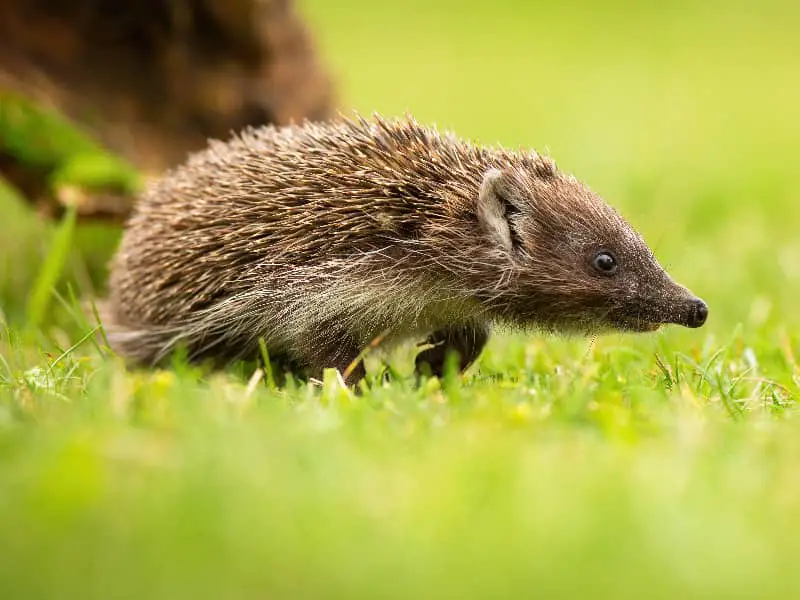
How fast is a hedgehog?
The question "How fast is a hedgehog?" is more fascinating than you might think at first glance. This blogpost will take you on a journey through the wonderful world of hedgehog speed.
What we know about the speed of hedgehogs
Hedgehogs are known for their spikes, but what about their speed? It may be surprising, but hedgehogs are anything but lame creatures. On the contrary, their speed can even be surprising when fleeing from danger or searching for food.
The average speed of a hedgehog is about 1.5 to 2 km/h, but there are exceptions that can easily exceed this speed. The European hedgehog, which most of us know, can even reach top speeds of up to 4 km/h. That may not sound like a sprinter, but for a small animal with short legs, that's pretty impressive.
Hedgehogs have evolved to cover short distances quickly to escape danger or snatch prey. They are not long-distance runners, but their locomotion is quite effective for their survival strategies.
Why the speed of hedgehogs is interesting
The speed of a hedgehog is not only an interesting biological issue, but also relevant to the interaction between hedgehogs and humans. Hedgehogs are often found in gardens and parks, and their speed can be crucial when it comes to crossing a road.
In the human environment, roads and cars are one of the main dangers for hedgehogs. Their speed can therefore be the difference between life and death. In addition, knowledge of hedgehog speed can be helpful in developing appropriate protective measures for these animals, whether in the form of hedgehog crossings or other structural changes.
As complex as the factors influencing a hedgehog's speed may be, the subject is fascinating. The combination of biology, behavior and human influence provides a variety of starting points for further research.
How fast is a hedgehog? - Different types of hedgehogs
The world of hedgehogs is much more diverse than many people think. Did you know that there are different hedgehog species that can differ in speed and behavior? In this section, we look at the European hedgehog and the African white-bellied hedgehog and compare their speeds.
European hedgehog
The European hedgehog (Erinaceus europaeus) is probably the best known hedgehog and is native to many parts of Europe. He is a nocturnal animal and is often seen in gardens, parks and forests.
This species can reach speeds of up to 4 km/h, especially when they are searching for food or trying to escape from danger. The physique of the European hedgehog is robust; it has short legs and a stocky body that helps it conserve energy while moving fast.
The speed of the European hedgehog also depends on various factors such as temperature and time of day. At dusk and at night they are the most active and, accordingly, the fastest.
African White-bellied Hedgehog
The African white-bellied hedgehog (Atelerix albiventris) is a smaller hedgehog species found in sub-Saharan Africa. It differs from its European relative in several aspects, including its speed.
In general, African White-bellied Hedgehogs are somewhat faster and more agile than European hedgehogs. This is mainly due to their slimmer build and longer legs. Their speed can vary depending on the situation and environment, but on average they reach about 6 km/h.
In addition to speed, agility also plays an important role. African white-bellied hedgehogs are able to turn quickly and change direction abruptly, which gives them an advantage in their natural environment.

How fast is a hedgehog - behavior and habitat
The speed of a hedgehog is not only determined by its biological characteristics, but is also strongly influenced by its behavior and habitat. So what role do the environment and the time of day play in the speed of these fascinating animals?
How the environment affects the speed
The environment in which a hedgehog lives has a considerable influence on its speed. While some hedgehogs live in densely overgrown woods or hedgerows, others are found in more open areas such as meadows or fields.
In densely vegetated areas, hedgehogs often move more slowly to avoid obstacles such as undergrowth or stones. Here, agility and maneuverability are often more important than pure speed. In open areas, on the other hand, hedgehogs can make better use of their maximum speed because there are fewer obstacles in the way.
In addition, factors such as ground conditions and slope play a role. A soft, muddy ground can significantly reduce speed, while a firm surface allows the hedgehog to run faster.
Time of day and activity: when are hedgehogs fastest?
Hedgehogs are predominantly nocturnal animals, which means that they are most active - and therefore fastest - at dusk and at night. Their nocturnal activity not only serves to protect them from predators, but also allows them to search for food in peace.
Studies have shown that hedgehogs are most active at dawn and shortly after sunset. During these periods, they are foraging and use their speed to scan large areas or sprint quickly toward would-be prey.
However, it is important to note that hedgehogs are not high-speed animals. Their activity peaks tend to be short periods when they reach their maximum speed. Throughout the day, they rest and save energy for the next phases of activity.
Conclusion: How fast is a hedgehog?
The question "How fast is a hedgehog?" may sound simple, but it leads into a multi-layered world full of interesting insights. As we have seen, the speed of a hedgehog is influenced by a number of factors, including the species of hedgehog, its behavior, and the habitat in which it resides.
While the European hedgehog can reach speeds of up to 4 km/h, the African white-bellied hedgehog is usually even faster and more agile. Both species have developed their own survival strategies, which are perfectly adapted to their respective habitats.
The speed of a hedgehog is also affected by the time of day and the environment. They are most active at dusk and at night, and their speed can be affected by the nature of the terrain. For example, they move faster on firm ground than on soft ground.
Broadly speaking, it appears that hedgehog speed is not only an interesting biological detail, but also has a significant impact on their survival strategies and their interaction with the human environment.
Author

-
Garden animal - A life with nature
Welcome to my animal blog! My name is Dirk and I am happy to take you on my journey through the fascinating world of animals and gardening.
Born 54 years ago, I have had an insatiable curiosity for the animal world around me since childhood. Although I have moved professionally in other industries, my true passion has always been animals and nature. It is remarkable how a small garden has become such an important part of my life.
Many of my fondest memories are associated with the animals that share our home. Whether it's the curious squirrels that scurry across the trees in the morning, the colorful variety of birds that visit our feeders, or the busy bees and butterflies that pollinate our flowers, every moment with them is invaluable to me.
This blog is my contribution to share my experiences, discoveries and insights with like-minded people. Here I will share stories of unforgettable encounters with animals, give tips on gardening and creating wildlife-friendly habitats, and take you on my journeys through nature.
Thank you so much for being here!
Cordial,
Dirk aka garden animal
Last posts
- 27. February 2024PetsVeganes Hundefutter – Grün und Gesund?
- 18. January 2024ChickensOregano für Hühner
- November 27, 2023HamsterDiurnal hamsters
- November 24, 2023HamsterHamster hammock






